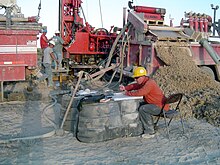Front door of the Oxford Internet Institute on St Giles, Oxford.
The Oxford Internet Institute (OII) is a
multi-disciplinary department of social and computer science dedicated
to the study of information, communication, and technology, and is part
of the Social Sciences Division of the University of Oxford, England. It is housed over three sites on St Giles in Oxford, including a primary site at 1 St Giles, owned by Balliol College. The department undertakes research and teaching devoted to understanding life online, with the aim of shaping Internet research, policy, and practice.
Founded in 2001, the OII has tracked the Internet's development
and use, aiming to shed light on individual, collective and
institutional behaviour online. The department brings together academics
from a wide range of disciplines including political science,
sociology, geography, economics, philosophy, physics and psychology.
The current director is Professor Philip N. Howard.
Research
Research at the OII covers a huge variety of topics, with faculty publishing journal articles and books on issues including privacy and security, e-government and e-democracy, virtual economies, smart cities, digital exclusion, digital humanities, online gaming, big data and Internet geography. The OII currently has the following research clusters reflecting the diverse expertise of faculty:
- Digital Politics and Government
- Information Governance and Security
- Social Data Science
- Connectivity, Inclusion and Inequality
- Internet Economies
- Digital Knowledge and Culture
- Education, Digital Life and Wellbeing
- Ethics and Philosophy of Information
The faculty and students of the OII have made many advances to the study of technology and society. Director Helen Margetts' book Political Turbulence was the first book-length manuscript on the impact of social media on public life. Viktor Mayer-Schönberger's
book Big Data was the first to define and explain the importance of big
data in contemporary economics, culture, and politics. His 2018 work Reinventing Capitalism in the Age of Big Data focuses on the role of platforms for allocating demand and supply beyond the price mechanism. Professor Philip N. Howard was the first political scientist to define and study astroturfing and has been responsible for significant research on fake news, bots and trolls in international affairs. Luciano Floridi is the world's leading ethicist on AI and big data.
Studies of Wikipedia
OII
has published several studies in Internet geography and Wikipedia. In
November 2011, the Guardian Data Blog published maps of geotagged Wikipedia articles written in English, Arabic, Egyptian Arabic, French, Hebrew and Persian. OII Senior Research Fellow Mark Graham led the study and published the results on his blog, Zero Geography.
Graham also leads an OII project focused on how new users are
perceived, represented, and incorporated into the Wikipedia community. In 2013, OII researchers led by Taha Yasseri published a study of controversial topics in 10 different language versions of Wikipedia, using data related to "edit wars".
As of late, the OII has, amongst other things, been involved in research on the effects of computational propaganda, the ethics of big data
in different contexts and the political implications of the Internet
and social media. It closely collaborates with other institutions of the
University of Oxford such as the Reuters Institute for the Study of
Journalism, the department for computer science and the Oxford Martin
School.
Teaching
Since 2006, the OII has offered a DPhil (doctoral) degree in "Information, Communication, and the Social Sciences." Since 2009, it has offered a one-year Master of Science (MSc) degree in "Social Science of the Internet". From 2015, prospective students can apply to study the MSc degree part-time over two years.
In addition, the department also runs an annual Summer Doctoral
Programme which brings outstanding PhD students to study at the OII for
two weeks each July. From 2018, prospective students also have the option to apply for a one-year Master of Science degree in Social Data Science with the related DPhil in Social Data Science available from 2020 onward.
History
The Oxford Internet Institute was made possible by a major donation from the Shirley Foundation of over £10m, with public funding totalling over £5m from the Higher Education Funding Council for England.
The idea originated with Derek Wyatt MP and Andrew Graham,
then Master-Elect of Balliol. Two Balliol Alumni, who knew Dame
Stephanie from The Worshipful Company of Information Technologists,
approached Dame Stephanie for support.
The Oxford Internet Institute is part of a small network of research centres that includes the centres like the Berkman Klein Center for Internet & Society and Information Society Project at Yale Law School. But it is the only one that functions as a fully functioning, degree-granting department.
Directors
- Andrew Graham Acting (2001-2002)
- William H. Dutton (2002–2011)
- Helen Margetts (2011–2018)
- Philip N. Howard (2018–present)
Faculty
- Helen Margetts
- Grant Blank
- Jonathan Bright
- Rebecca Eynon
- Luciano Floridi
- Mark Graham
- Philip N. Howard
- Vili Lehdonvirta
- Victoria Nash
- Eric T. Meyer
- Gina Neff
- Ralph Schroeder
- Greg Taylor
- Viktor Mayer-Schönberger
- Taha Yasseri
OII awards
For
its 10th anniversary the OII launched the OII awards for lifetime
achievement awards on the internet research field and the Internet &
Society awards for significant recent contribution to develop the
internet for public good.
Lifetime achievement awards winners
2016:
2014:
- Sir Tim Berners-Lee
- Dame Steve Shirley
- Barry Wellman
2013:
2012:
- Professor Yochai Benkler
2011:
- Professor Manuel Castells
- Dr Vinton G. Cerf
- Dr David Clark
- Professor William H. Dutton
- Professor Dame Wendy Hall
- Mr. Joi Ito
- Mr. Niklas Zennström
Internet and society awards
2016:
- Shami Chakrabarti
- Mike Bracken
- Juliana Rotich
2014:
2013:
2012:
2011:







